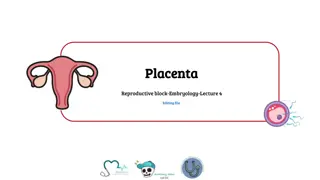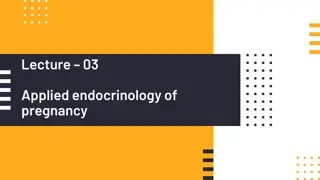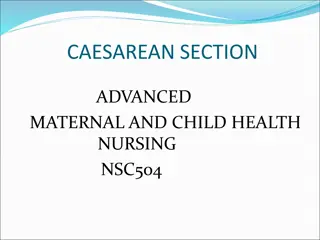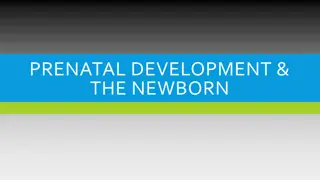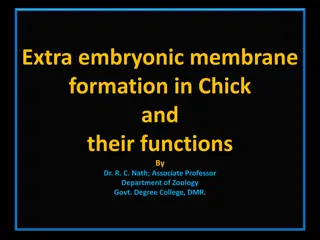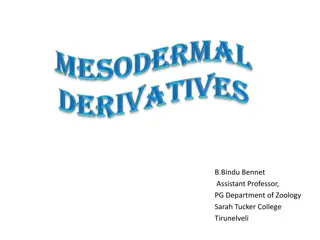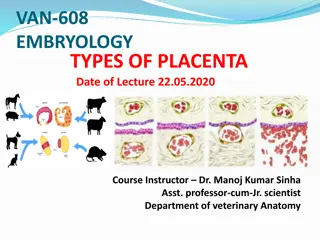Understanding Antepartum Haemorrhage and Placenta Praevia
Antepartum haemorrhage, especially in cases of placenta praevia, can present challenges in pregnancy. This condition, where the placenta covers or is near the cervix, requires careful monitoring and may necessitate interventions like ultrasound scans and potential hospital admissions. Risk factors f
7 views • 15 slides
Understanding the Placenta: Structure and Function
The placenta is a crucial organ in pregnancy, facilitating the exchange of gases and nutrients between mother and fetus. Learn about its formation, components, surfaces, and functions in this comprehensive overview.
0 views • 10 slides
Placenta Accreta Syndrome: Definition, Risk Factors, Diagnosis, and Management
Placenta Accreta Syndrome (PAS) is characterized by abnormal placental implantation with firm adherence to the uterine muscle due to the absence of certain layers. Risk factors include previous cesarean section, placenta previa, advanced maternal age, and uterine anomalies. Diagnosis involves ultras
0 views • 16 slides
Endocrinological Aspects of Pregnancy: Hormones, Functions, and Synthesis
During pregnancy, endocrinological structures like the corpus luteum and placenta play vital roles in the production of hormones such as progesterone and estrogens. Progesterone maintains pregnancy by controlling essential functions like endometrial differentiation, myometrial quiescence, and local
4 views • 15 slides
Comprehensive Overview of Caesarean Section and Uterine Anatomy
Caesarean section (C/S) is an operative procedure done under anesthesia to deliver the fetus, placenta, and membranes through an incision in the abdominal wall and uterus. The history of C-section dates back to the 17th century, with significant advancements in the modern era. Understanding the anat
1 views • 60 slides
Exploring Prenatal Development and Newborn Reflexes
Delve into the wonders of prenatal development from conception to birth, including the societal implications of delayed childbearing and ethical considerations like human cloning. Discover the stages of embryonic growth, the role of the placenta, and the impact of teratogens. Explore reflexes in com
0 views • 10 slides
Understanding the Impact of Drugs on Pregnancy Development
This lecture covers factors influencing placental transfer, harmful effects of drugs at different developmental stages, FDA classifications of drugs, and teratogenic drugs. It explains how drugs cross the placenta, including physiochemical properties and stage of development affecting transfer. The
0 views • 10 slides
Extra Embryonic Membrane Formation in Chick and Their Functions
The development of extra embryonic membranes in chick embryos plays a crucial role in their growth and protection. These membranes, including the amnion and chorion, serve various functions such as providing protection, facilitating gas exchange, and supporting the formation of the placenta. Underst
0 views • 20 slides
Development of Extraembryonic Membranes in Frog Embryos
The developmental stages of extraembryonic membranes in frog embryos are visually illustrated in a series of images. These images showcase the intricate processes involved in the formation of structures such as the amnion, chorion, yolk sac, and allantois, leading up to the development of the placen
0 views • 18 slides
Understanding Ecology and Biodiversity
Ecology explores the dynamic interactions between living (biotic) and non-living (abiotic) factors in ecosystems. It delves into selective breeding, protein structure, hormones, placenta function, and the vulnerability of embryos during early development. Meiosis, mRNA translation, feedback mechanis
0 views • 25 slides
Types of Placenta in Embryology: Classification and Structure
The lecture discusses the classification of placenta based on the mode of attachment and distribution of chorionic villi. It covers folded, villous, and labyrinthine placenta along with diffuse, cotyledonary, zonary, and discoidal placenta types in different species. The structure of placenta involv
0 views • 16 slides
Understanding Stem Cells and Cell Potency in Animal Cells
Stem cells play a crucial role in animal cells, offering the potential to differentiate into various cell types. Totipotent stem cells are the most versatile, capable of developing into any cell type in the embryo, including extra-embryonic cells. Pluripotent stem cells can give rise to all body cel
0 views • 22 slides

